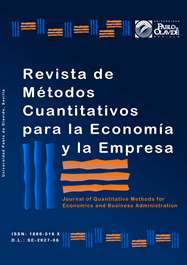Analysis of Determinants and Costs of Informality in Small Businesses: An Empirical Study for Peru
DOI:
https://doi.org/10.46661/revmetodoscuanteconempresa.2915Keywords:
exclusión, impuestos, beneficios, probabilidad, exclusion, taxes, profits, probabilityAbstract
Informality in small businesses is a widespread phenomenon in Latin American countries. In Peru it represents 50% of the business units, a situation that implies the knowledge of the determinants of this reality to contribute to the design of public policies. Thus, the present work studies the variables related to the productive performance and the life quality of the company owner’s home as elements highly related to informality. In addition, it is evaluated whether the employer’s decision about informality responds to a maximization of profits or, on the contrary, it is due to exclusion because the current legislation is apart from the real nature of the business unit. The conclusions allow observing that the characteristics of the home facilitate the formality and that the existing tax regulatory framework excludes small companies, which experience lower levels of profit compared to formal companies with similar characteristics.
Downloads
References
Auriol, E. y Warlters, M. (2005). Taxation base in developing countries. Journal of Public Economics, 89 (4), pp. 625-646.
Cebula, R. (1997). An empirical analysis of the impact of government tax and auditing policies on the size of the underground economy: The case of the United States, 1973–94. American Journal of Economics and Sociology, 56 (2), pp. 73-186.
Dabla-Norris, E., Gradstein, M. e Inchauste, G. (2008). What causes firms to hide output? The determinants of informality. Journal of Development Economics, 85 (1) (2), pp. 1-27.
De Soto, Hernando. (1989). The other path: The invisible revolution in the third world. HarperCollins.
De Mel, S., Mckenzie, D. y Woodruff, C. (2013). The demand for, and consequences of, formalization among informal firms in Sri Lanka. American Economic Journal: Applied Economics, 5 (2), pp. 122-150.
Fajnzylber, P., W. Maloney y G. Montes-Rojas (2011). Does formality improve micro-firm performance? Quasi-experimental evidence from the Brazilian SIMPLES Program. Journal of Development Economics 94, pp. 262-276.
Friedman, E., Johnson, S., Kaufman, D. y Zoido-Lobaton, P. (2000). Dodging the grabbing hand: The determinants of unofficial activity in 69 countries. Journal of Public Economics 76 (3), pp. 459-492.
Galiani, S. y Weinschelbaum, F. (2008). Modelling informality: Households and firms. Economic Inquiry, 50 (3), pp. 821-838.
Gulyani, S. y Debabrata T. (2010). Inside informality: The links between poverty, microenterprises, and living conditions in Nairobi´s slums. World Development, 38 (12), pp. 1710-26.
Jäckle, A. y Li, C. (2006). Firm dynamics and institutional participation: A case study on informality of micro enterprise in Peru. Economic Development and Cultural Change, 54 (3), pp. 557-578.
Loayza, N. (1996). The economics of the informal sector. A simple model and empirical evidence from Latin America”. Carnegie – Rochester Conference Series on Public Policy, 45, pp. 129-162.
Levy, S. (2008). Good intentions, bad outcomes: Social policy, informality, and economic growth in Mexico. Brookings Institution Press.
Ministerio de la Producción. (2013). La Mipymes en cifras 2013.
Meier, K., Kirchler, E. y Hubert, A. (1999). Savings and investment decisions within private households: Spouse´s dominance in decisions on various forms of investment. Journal of Economy Psychology, 20, pp. 499-519.
Perry, G., W. Maloney, O. Arias, P. Fajnzylber, A. Manson y J. Saavedra (2007). Informality: Exit and exclusion. The World Bank. Washington, D. C.
Rosenbaum y Rubin. (1983). The central role of the propensity score in observational studies for causal effects. Biometrika, 79 (1), pp. 41-55.
Straub, S. (2005). Informal sector: The credit market channel. Journal of Development Economics, 78 (2), pp. 299-321.
Williams, C., Shahid, M. y Martínez, A. (2015). Determinants of the level of informality of informal micro-enterprises: Some evidence from the city of Lahore, Pakistan. World Development, 84, pp 312-325.
Downloads
Published
How to Cite
Issue
Section
License
Copyright (c) 2019 Journal of Quantitative Methods for Economics and Business Administration

This work is licensed under a Creative Commons Attribution-ShareAlike 4.0 International License.
Submission of manuscripts implies that the work described has not been published before (except in the form of an abstract or as part of thesis), that it is not under consideration for publication elsewhere and that, in case of acceptance, the authors agree to automatic transfer of the copyright to the Journal for its publication and dissemination. Authors retain the authors' right to use and share the article according to a personal or instutional use or scholarly sharing purposes; in addition, they retain patent, trademark and other intellectual property rights (including research data).
All the articles are published in the Journal under the Creative Commons license CC-BY-SA (Attribution-ShareAlike). It is allowed a commercial use of the work (always including the author attribution) and other derivative works, which must be released under the same license as the original work.
Up to Volume 21, this Journal has been licensing the articles under the Creative Commons license CC-BY-SA 3.0 ES. Starting from Volume 22, the Creative Commons license CC-BY-SA 4.0 is used.










